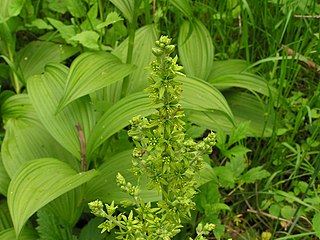
Veratrum viride, known as Indian poke, corn-lily, Indian hellebore, false hellebore, green false hellebore, or giant false-helleborine, is a species of Veratrum native to eastern and western North America. It is extremely toxic, and is considered a pest plant by farmers with livestock. The species has acquired a large number of other common names within its native range, including American false hellebore, American white hellebore, bear corn, big hellebore, corn lily, devil's bite, duck retten, itchweed, poor Annie, blue hellebore and tickleweed.

Maianthemum dilatatum is a common rhizomatous perennial flowering plant that is native to western North America from northern California to the Aleutian islands, and Asia across the Kamchatka Peninsula, Japan, and Korea. It grows in coastal temperate rainforests, and is often the dominant groundcover plant in Sitka Spruce forests.

Veratrum insolitum is a species of false hellebore, a type of plant closely related to the lily. Its common name is Siskiyou false hellebore. It is native to the northwestern United States: Washington, western Oregon, and northwestern California as far south as Trinity County.
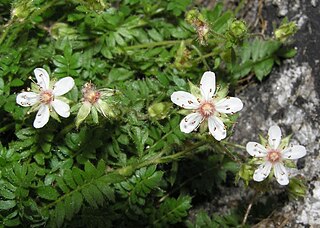
Ivesia callida is a rare species of flowering plant, in the rose family, known by the common name Tahquitz mousetail. It is a small perennial herb which forms matted patches of hanging foliage on cliff faces. The leaves are strips of oval-shaped green leaflets. Each leaf is up to 7 centimeters long and has several pairs of hairy, glandular leaflets. The thin, green, hanging stems grow up to 15 centimeters long and bear an inflorescence of several flowers. Each flower has five hairy, pointed sepals and five round to oval white petals. The center of the flower contains twenty stamens with disc-shaped anthers and several pistils.

Ivesia webberi is a species of flowering plant in the rose family known by the common names wire mousetail and Webber's ivesia. It is native to the United States, where it occurs in the northernmost part of the Sierra Nevada and the adjacent Modoc Plateau in California, its range extending just into Nevada.
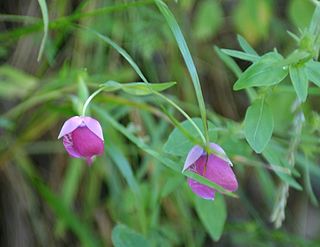
Calochortus amoenus is a species of flowering plant in the lily family which is commonly known as purple fairy-lantern.

Calochortus dunnii is a rare species of flowering plant in the lily family known by the common name Dunn's mariposa lily.

Calochortus obispoensis is a rare California species of flowering plants in the lily family known by the common name San Luis mariposa lily. It is endemic to San Luis Obispo County, California, where it grows in the chaparral of the coastal mountains, generally on serpentine soils.
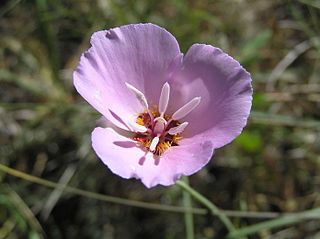
Calochortus palmeri is a species of flowering plant in the lily family known by the common names Palmer's mariposa lily and strangling mariposa.

Calochortus panamintensis is a rare North American species of flowering plants in the lily family known by the common name Panamint mariposa lily. It is native to Inyo and Kern Counties in California, plus adjacent Nye County, Nevada. It is named after the Panamint Range near Death Valley.

Prosartes hookeri is a North American species of flowering plants in the lily family known by the common names drops of gold and Hooker's fairy bells.

Lewisia congdonii, known by the common name Congdon's lewisia, is a rare species of flowering plant in the family Montiaceae.

Mertensia ciliata is a species of flowering plant in the borage family known by the common names tall fringed bluebells, mountain bluebells, and streamside bluebells.
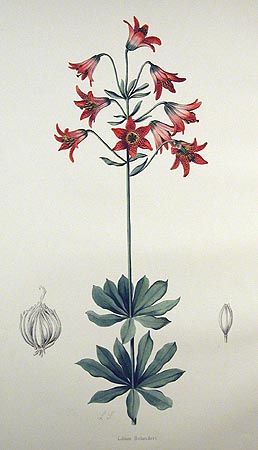
Lilium bolanderi is a rare North American species of plants in the lily family, known by the common name Bolander's lily. It is native to northwestern California and southwestern Oregon.

Pyrrocoma apargioides is a species of flowering plant in the family Asteraceae known by the common name alpineflames. It is native to the western United States from the Sierra Nevada of California east to Utah, where it grows in the forests and meadows of high mountains. It is a perennial herb growing from a taproot and producing one or more stems to 30 centimeters in length. The stems are decumbent or upright, reddish, and hairless to slightly woolly. Most of the leaves are located around the base. They are thick and leathery, lance-shaped with large sawteeth along the edges, often center-striped in white, and measure up to 10 centimeters long. The inflorescence is usually a single flower head lined with centimeter-long phyllaries which are reddish to green with red edges. The head has a center of yellow disc florets and a fringe of ray florets which are yellow, often splashed with red along the undersides, measuring up to 1.6 centimeters in length. The fruit is an achene which may be well over a centimeter in length including its pappus.
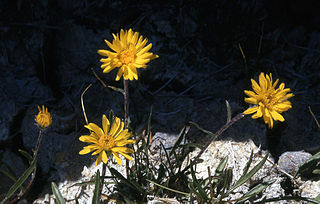
Pyrrocoma uniflora is a species of flowering plant in the family Asteraceae known by the common name plantain goldenweed. It is native to western North America from central Canada to California to Colorado, where it grows in several types of habitat, including forest and meadows with alkali soils, such as those near hot springs. It is a perennial herb growing up to 40 centimeters tall, the stems reddish and usually with a thin to thick coating of woolly fibers. The lance-shaped, toothed leaves are usually woolly, the largest near the base of the plant reaching up to 12 centimeters in length. The inflorescence is a single flower head or a cluster of a few heads, each lined with woolly phyllaries. The head contains yellow disc and ray florets. The fruit is an achene which may be over a centimeter long including its long pappus.
Silene marmorensis is a rare species of flowering plant in the family Caryophyllaceae known by the common names Marble Mountain catchfly, Marble Mountain campion, and Somes Bar campion. It is endemic to the southern Klamath Mountains of northern California, where it grows in mountain woodlands and forests. It is a perennial herb producing several stems and shoots from a woody, branching caudex and thick taproot. The hairy, glandular stems grow erect to a maximum height near 40 centimeters. The lance-shaped leaves are a few centimeters long and are borne in pairs, the lowermost drying early. The inflorescence is a terminal cyme of flowers at the top of the stem, and some flowers may occur in the leaf axils. Each flower has a hairy, veined calyx of fused sepals. The flowers bloom at night, the five pinkish or green-tinged petals opening at the tip of the calyx.

Streptanthus vernalis is a rare species of flowering plant in the mustard family known by the common name early jewelflower. It was first observed in the 1970s but not actually described to science until 2005. It is endemic to Lake County, California, where it is known from a single occurrence at Three Peaks near the Napa County line. It is apparently limited to serpentine outcrops in forested and chaparral habitat. Genetic analysis indicates that the species is distinct from other Streptanthus and is most closely related to Streptanthus morrisonii, which it resembles. It is a hairless annual herb producing an erect branching or unbranched stem 2 to 20 centimeters tall. The ephemeral basal leaves have thick, fleshy leaves which are green and unmottled on top and purple on the undersides. Leaves higher on the stem are linear to lance-shaped and lack petioles. Flowers occur at intervals along the upper stem. Each flower has an urn-shaped calyx of sepals which is solid green with no purple or yellowish tinge. The petals emerging from the tip are white without darker veining. The fruit is a flattened straight silique 3 to 5 centimeters long containing orange seeds.

Calochortus syntrophus is a rare species of flowering plant in the lily family known by the common names Callahan's mariposa lily and clustered mariposa lily. It is endemic to northern California, where it occurs in a remote area north of Montgomery Creek in Shasta County. It has also been spotted in adjacent Tehama County. Its habitat includes open, rocky areas with moist or wet soils in oak woodland territory. It was first discovered in 1993 and its description was published the following year.

Erythronium taylorii is a rare species of flowering plant in the lily family known by the common names Pilot Ridge fawn lily, Taylor's fawnlily, and Yosemite fawn lily. It is endemic to Tuolumne County, California, where it is known only from Pilot Ridge, a remote mountain ridge outside of Yosemite National Park. It was discovered in 1996 and described to science as E. taylori in 1997, and it is now called E. taylorii. There are at least 1000 individuals in the single known population. It occurs on shaded north-facing cliffs.



















